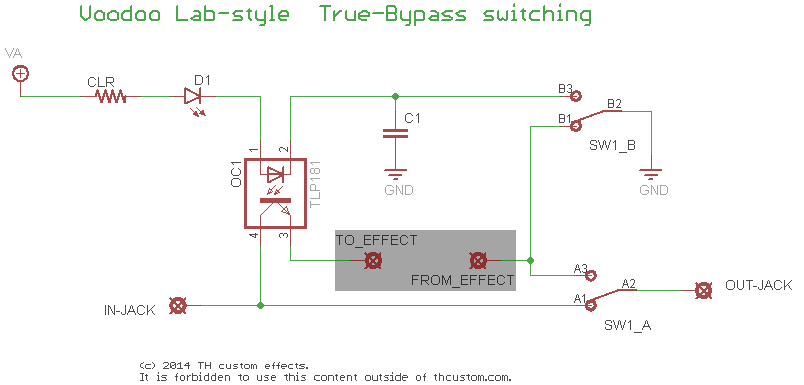Knowledgebase
Switching: 2PDT True Bypass – The Voodoo Lab version
True-Bypass or not:
There is another solution using a 2PDT switch which has caused some discussions if it is True-Bypass or not. In the end we see that the effect is not in the circuit at all when the effect is switched off. So it is True-Bypass.
How it works:
This one is using an optocoupler to get things done with only a 2PDT switch.
When the effect is OFF:
The IN-JACK is directly connected to the OUT-JACK via SW1A.
At the same time SW1B is switching the effect output to Ground – discharging the output coupling capacitor of the effect (read this article about “popp”). The LED circuit is open and no current flows through LED and optocoupler which causes the transistor in the optocoupler to open and disconnect the input of the effect from the IN-JACK (via a high resistance of 1M-10M)
When the effect is ON:
The IN-JACK is disconnected from the OUT-JACK via SW1A. Instead the output of the effect is now connected to the OUT-JACK.
At the same time SW1B is connecting the LED and optocoupler circuit to ground causing the LED and the optocoupler to light up which makes the transistor in the optocoupler go low resistance ( <300 Ohm ) and therefore connect the JACK-IN signal to the effect circuit.
1776 effects has a nice PCB for you called the Opto-Tron.



Do you know what’s the purpose of C1?
Its smoothing out spikes that could occour during switching the optocoupler on/off.
Could this Optocoupler circuit be used to mod an existing pedal that has a dpdt switch?
I have recently bought an old Marshall Drivemaster which sounds excellent but there is significant treble loss when switched off.
Appreciate I could use a bypass loop but it would be neat to upgrade the unit if it can be done at low cost.
I couldnt find an original Drivemaster schematic which includes the switching part, so I dont know. If it is true bypass then usually the answer is yes, if it is a buffered switching or else one has to look into details.